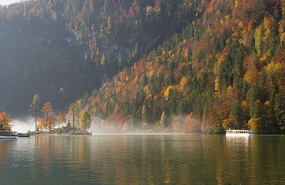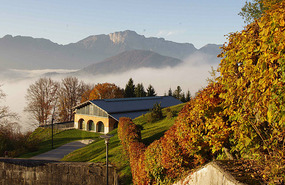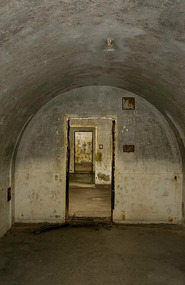We were back in Germany, near the Königsee, now having driven north from Forni di Sopra. We pulled into the campsite in the dark the previous night so we had no idea of what our surroundings looked like. We woke up to the campsite being enveloped in fog but I could see some of the surrounding mountains. I went over to the reception to pay for our camping and checked out the weather forecast for the day.
It was the funniest weather forecast I've read: "We can raise our expectations of the weather today as the sun will clear the fog in the late morning". Raise our expectations, eh? Well, I would do that then. So we packed up camp and then went for a stroll along the river from our campsite out to Königsee (King’s Lake). It was a beautiful day out and the fog was indeed clearing as we had been led to believe. We walked around the lake for a bit to a viewpoint and decided against a boat cruise as most of the lake was still socked in with fog.
After returning to the campsite along the same path, we drove off to our next site, the nearby Nazi Documentation center in Berchtesgaden. They had built a documentation center here because it was the site of Hitler’s retreat, the infamous, “Eagle’s Nest”. Hitler was Austrian by birth and had selected this region in Austria for its scenic beauty to be his personal retreat and also where he hosted numerous diplomats.
It also served as part of his propaganda machine to show him as a humble, down to earth person, connected with nature – one of the people. It was here that he met the little blond Austrian girl which he is featured with in numerous propaganda pieces that portray him not just as führer, but a father to the nation. Hitler later found out that the girl was of Jewish descent but he conveniently chose to ignore this (and probably fortunately for the girl) as his portrayal with the little girl in various media from postcards to posters was so successful.
It was a steep road up to the documentation center and we were afforded with a sweeping view of the surrounding valley. The Eagle’s Nest, coined by a visiting dignitary, is up a private toll road and is now just a café as opposed to a museum so we decided to spend more time visiting the documentation center instead. It was at the Eagle’s Nest that Hitler is believed to have finished writing his book, “Mein Kampf”. It is one of the surviving icons of Nazi-ism and Hitler owning to the fact that it was too difficult to bomb aerially because it is literally perched on a mountain top. The center occupies a small fraction of the bunkers that Hitler had built as his last line of defense. Since it is perched at an excellent vantage point, it was also ideal to defend against an attack. The bunker was fully equipped at the time of the war and also included airlocks, a state of the art plumbing and heating system and fully stocked pantries – I guess even a megalomaniac prepares for the eventuality of defeat.
This was the first Nazi related site either of us had visited on this trip and we weren’t sure what to expect. It was a very well laid out museum and you got to walk through sections of the bunker. The bunkers were never actually used in the end. Half of the museum was mainly focused on how Hitler transformed Oberamergau for his own purposes and how the region was affected. The other half of the museum gave an overview about the propaganda machine, Hitler youth, the rise of the party, the Munich agreement (which without representation from the affected parties, left Austria and the Czech Republic to be annexed) and about the progression of the war. The museum had excellent English pamphlets with translations of the major displays which really helped us to get a better understanding.
There was a special exhibition in the bunkers that had been shown for the first time at the World Congress for Psychiatry in Hamburg in 1999. It was not until the 1980s that the psychiatric profession in Germany really began to take accountability for the atrocities committed by its members. As they began the process of reforming the neglected psychiatric hospitals, it was decided that an essential pre-requisite for planning the future was to first understand the past, namely the events of WWII. Many psychiatrists in Germany were still opposed to confronting the truth – in fact, only as of 2010, did the President of the DGPPN (Germany Society for Psychiatry, Psychotherapy, and Neurology) make a public apology for the crimes committed by its members during the Nazi reign. During the period of 1939-1945, over 200,000 mentally ill persons were murdered as part of the national socialist party’s 'Euthanasia Program’.
The exhibit was put together by psychiatrists as one way to begin understanding and dealing with the gruesome reality. It was a really chilling exhibit for me personally and it still haunts me as I write about it today. I didn’t take any close-up pictures of the display panels partly out of respect for the solemnity of the exhibit and also partly because it is the stuff of nightmares that is engrained in my memory. I think what struck home the hardest was the casualness with this which innocent, and in most cases, helpless, people were murdered (either outright or as a result of experiments gone sideways) by so-called intelligent and respected medical professionals whose mission should have been to aid, not destroy. This was followed by the fact that their deaths were then subsequently covered up just as casually and the victims’ relatives lied to. The exhibit wasn’t mean to answer the question of “why?” or “how?” – it aimed to simply present the findings without bias. It definitely left me with lots of questions occupying my mind.
Berchtesgaden
Tuesday, October 23, 2012
 Berchtesgaden, Bavaria, Germany
Berchtesgaden, Bavaria, Germany
Other Entries
-
38Mont Ventoux
Sep 1835 days prior Malaucene, Francephoto_camera47videocam 0comment 1
Malaucene, Francephoto_camera47videocam 0comment 1 -
39Escargots & Grenouilles
Sep 1934 days prior Pont en Royans, Francephoto_camera44videocam 0comment 4
Pont en Royans, Francephoto_camera44videocam 0comment 4 -
40Choranche Caves
Sep 2033 days prior Pont en Royans, Francephoto_camera30videocam 0comment 3
Pont en Royans, Francephoto_camera30videocam 0comment 3 -
41Cinque Terre
Sep 2231 days prior Levanto, Italyphoto_camera55videocam 0comment 2
Levanto, Italyphoto_camera55videocam 0comment 2 -
42Venice
Sep 2528 days prior Venice, Italyphoto_camera96videocam 0comment 6
Venice, Italyphoto_camera96videocam 0comment 6 -
43Forni di Sopra, a quick visit
Sep 2627 days prior Forni di Sopra, Italyphoto_camera16videocam 0comment 0
Forni di Sopra, Italyphoto_camera16videocam 0comment 0 -
44Davos
Sep 3023 days prior Davos, Switzerlandphoto_camera46videocam 1comment 1
Davos, Switzerlandphoto_camera46videocam 1comment 1 -
45Schilthorn and North face walk
Oct 0221 days prior Lauterbrunnen, Switzerlandphoto_camera56videocam 3comment 5
Lauterbrunnen, Switzerlandphoto_camera56videocam 3comment 5 -
46To the "Top of Europe"
Oct 0320 days prior Lauterbrunnen, Switzerlandphoto_camera76videocam 5comment 7
Lauterbrunnen, Switzerlandphoto_camera76videocam 5comment 7 -
47The Rothorn and Schynige Platte
Oct 0518 days prior Lauterbrunnen, Switzerlandphoto_camera73videocam 0comment 2
Lauterbrunnen, Switzerlandphoto_camera73videocam 0comment 2 -
48Mannlichen and First
Oct 0617 days prior Lauterbrunnen, Switzerlandphoto_camera39videocam 0comment 1
Lauterbrunnen, Switzerlandphoto_camera39videocam 0comment 1 -
49Castles in Bavaria
Oct 0815 days prior Füssen, Germanyphoto_camera47videocam 1comment 2
Füssen, Germanyphoto_camera47videocam 1comment 2 -
50Linderhof Palace & Rococo churches
Oct 1013 days prior Linderhof, Germanyphoto_camera39videocam 0comment 4
Linderhof, Germanyphoto_camera39videocam 0comment 4 -
51Munich
Oct 1211 days prior Munich, Germanyphoto_camera157videocam 0comment 5
Munich, Germanyphoto_camera157videocam 0comment 5 -
52Herrenchiemsee palace
Oct 1310 days prior Herrnchiemsee, Germanyphoto_camera9videocam 0comment 1
Herrnchiemsee, Germanyphoto_camera9videocam 0comment 1 -
53Innsbruck
Oct 149 days prior Innsbruck, Austriaphoto_camera85videocam 0comment 7
Innsbruck, Austriaphoto_camera85videocam 0comment 7 -
54Return to Forni di Sopra
Oct 212 days prior Forni di Sopra, Italyphoto_camera24videocam 0comment 5
Forni di Sopra, Italyphoto_camera24videocam 0comment 5 -
55Berchtesgaden
Oct 23 Berchtesgaden, Germanyphoto_camera18videocam 0comment 1
Berchtesgaden, Germanyphoto_camera18videocam 0comment 1 -
56Salzburg
Oct 241 day later Salzburg, Austriaphoto_camera48videocam 0comment 0
Salzburg, Austriaphoto_camera48videocam 0comment 0 -
57Hallstatt
Oct 252 days later Hallstatt, Austriaphoto_camera37videocam 0comment 3
Hallstatt, Austriaphoto_camera37videocam 0comment 3 -
58Mauthausen Concentration Camp
Oct 263 days later Mauthausen, Austriaphoto_camera22videocam 0comment 1
Mauthausen, Austriaphoto_camera22videocam 0comment 1 -
59Melk Abbey
Oct 274 days later Melk, Austriaphoto_camera66videocam 0comment 1
Melk, Austriaphoto_camera66videocam 0comment 1 -
60Vienna
Oct 318 days later Vienna, Austriaphoto_camera133videocam 0comment 1
Vienna, Austriaphoto_camera133videocam 0comment 1 -
61Telc & Trebon
Nov 0210 days later Telc, Czech Republicphoto_camera23videocam 0comment 1
Telc, Czech Republicphoto_camera23videocam 0comment 1 -
62Cesky Krumlov
Nov 0311 days later Cesky Krumlov, Czech Republicphoto_camera25videocam 0comment 1
Cesky Krumlov, Czech Republicphoto_camera25videocam 0comment 1 -
63Prague
Nov 0614 days later Prague, Czech Republicphoto_camera83videocam 2comment 4
Prague, Czech Republicphoto_camera83videocam 2comment 4 -
64Kutna Hora and Terezin Ghetto
Nov 0715 days later Terezin, Czech Republicphoto_camera33videocam 0comment 3
Terezin, Czech Republicphoto_camera33videocam 0comment 3 -
65Christmas Town of Seiffen
Nov 0917 days later Seiffen, Germanyphoto_camera49videocam 0comment 5
Seiffen, Germanyphoto_camera49videocam 0comment 5 -
66Nazi Party Rally Grounds in Nuremberg
Nov 1119 days later Nuremberg, Germanyphoto_camera21videocam 0comment 1
Nuremberg, Germanyphoto_camera21videocam 0comment 1 -
67Rothenburg
Nov 1220 days later Rothenburg ob der Tauber, Germanyphoto_camera50videocam 0comment 1
Rothenburg ob der Tauber, Germanyphoto_camera50videocam 0comment 1 -
68Planes, Trains and Automobiles
Nov 1422 days later Mulhouse, Francephoto_camera34videocam 0comment 6
Mulhouse, Francephoto_camera34videocam 0comment 6 -
69Beaune
Nov 1523 days later Beaune, Francephoto_camera60videocam 0comment 7
Beaune, Francephoto_camera60videocam 0comment 7 -
70Royan
Nov 1927 days later Royan, Francephoto_camera9videocam 0comment 4
Royan, Francephoto_camera9videocam 0comment 4 -
71A second visit to London
Nov 2533 days later London, United Kingdomphoto_camera93videocam 0comment 15
London, United Kingdomphoto_camera93videocam 0comment 15 -
72En route to Bangalore
Nov 2634 days later Dubai, United Arab Emiratesphoto_camera10videocam 0comment 3
Dubai, United Arab Emiratesphoto_camera10videocam 0comment 3 -
73Bangalore
Dec 1654 days later Bangalore, Indiaphoto_camera134videocam 0comment 17
Bangalore, Indiaphoto_camera134videocam 0comment 17

 Berchtesgaden, Bavaria, Germany
Berchtesgaden, Bavaria, Germany


























2025-05-22